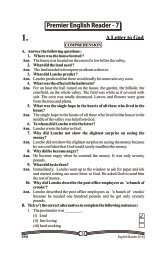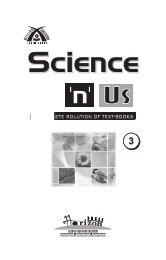Science 'N' us-5 final - School Books Publishers India
Science 'N' us-5 final - School Books Publishers India
Science 'N' us-5 final - School Books Publishers India
- No tags were found...
You also want an ePaper? Increase the reach of your titles
YUMPU automatically turns print PDFs into web optimized ePapers that Google loves.
<strong>Science</strong>'n'UsA COMPLETE SOLUTION OF TEXT-BOOKS5
2.REPRODUCTION IN PLANTSExerciseA. Answer the following questions :1. What is reproduction? What are the different methods of reproductionin plants?Ans. Plants produce this own kind. This process is called reproduction.Different methods of reproduction in plants are :(i) Reproduction through seeds(ii) Reproduction through spores(iii) Reproduction through their body parts2. What is germination? What are the conditions necessary for it?Ans. Inside the seed, there is a tiny plant called the embryo. If the seed isgiven water, air and warmth, it comes to life. The embryo begins togrow. This process is called germination. The main condition forgermination is to given water, air and warmth to grow.3. Describe structure of a seed.Ans. The structure of a seed : It is hard and cannot broken easily beca<strong>us</strong>e ithas a thick outer covering called the seed coat. It protects the seed. Onone side of the seed there is a scar. This is where the seed was attachedto the fruit. On the top of the scar, we can observe a small hole. This holeallows water to enter the seed.4. What is meant by seed dispersal?Ans. A plant produces large number of seeds. If all these seeds fall under theparent plant, the plants grown from them will fight for this survival.Seed should spread to far off places and away from the parent plant toavoid over crowding and thereby the competition of light, water andnutrients. This scattering of seed or fruits away from the mother plant iscalled dispersal.5. How do animals help in the dispersal of seeds?Ans. The animal eats the fruits, but only the juicy part is digested. The seed passthrough the animal's digestive system and are excreted. This can happenfor away from the parent plant. In this way, animals help in seed dispersal.6. What is vegetative propagation? Name any two plants thatreproduce in this way.Ans. The method of reproduction in which plants reproduce by the bodyparts like roots, stems and leaves is called vegetative propagation.1. Rose plant 2. leaf of bryophyllumHorizon Press107<strong>Science</strong> 'n' Us - 1 to 5
B. Choose the correct word from side box and fill in the blanks :1. Seeds are found in fruits embryo2. Seeds need air, water and warmth for germination. buds3. An embryo consists of a root and a shoot. air4. Potato and ginger grow from their buds. seeds5. The small hole in the seed coat to allow water micropyleinside is called micropyle.waterC. Name the way of reproduction in the following :1. Mango Reproduction through seeds2. Rose Reproduction by plant parts3. Fern Reproduction through spores4. Bryophyllum Reproduction by plant parts5. Ginger Reproduction by plant parts6. Papaya Reproduction through seedsFlowchartFill up the boxes to complete the flowcharts :(a)Methods of Reproduction in Plantsthrough sporesby plant partsthrough seeds(b)Agents of Seed Dispersalwater dispersalwind dispersal animal dispersal by explosionLet <strong>us</strong> EnjoyEnjoy to draw all the different stages of germination of a seed into a plant :(See space in text-book)Ans. Do yourself.Fun Time Activity1. Take some seeds of gram and put them as :(a) 2 in earthen pot filled with desert sand.(b) 2 in air tight bottle full of water.(c) 2 in earthen pot with soil and watered regularly. Observe them for10 days and note down your observations here.Ans. Do yourself.2. Take an onion or ginger bulb and put it in the wet soil in an earthen pot.Keep watering it regularly for some days. Study its growth and disc<strong>us</strong>syour observations with your science teacher.Ans. Do yourself.Horizon Press108<strong>Science</strong> 'n' Us - 1 to 5
3.THE LIFE OF ANIMALSExerciseA. Answer the following questions :1. What special features do carnivores have according to their foodhabits?Ans. Carnivores have long, sharp and pointed teeth. They can also chew thebones easily. These animals have strong claws and sharp nails.2. Why do animals move?Ans. Movement in animals is mainly in search of food, shelter, mate andprotection.3. What is rumination?Ans. Some herbivores such as cow, buffalo, etc first cut and swallow theirfood and then bring it back to their mouth and chew it. The process ofbringing back the food to mouth for chewing is called rumination.4. Which special features help a bird to fly?Ans. Birds have wings to fly. Their bones are hollow which make their bodylight in weight.5. How does spider trap its prey?Ans. Spider traps the insects in its web.6. Differentiate between diurnal and nocturnal animals.Ans. Animals which are active during the day time are called diurnal animals.Animals which are active during night called nocturnal animals.B. Choose the correct word from side box and fill in the blanks :1. Animals move differently and eat different kinds of food. webbed2. Carnivores feed on flesh only. different3. Animals which feed on insects only are calledinsectivores.insectivores4. Tiny air holes on the body of insects are called spiracles. carnivores5. Ducks have webbed feet. hollow6. A bird's bones are hollow which make it light. spiraclesC. Write True or False against the following statements :1. All animals need food, water and air. True2. Lion and tiger are herbivores. False3. Cow and giraffe are omnivores. False4. Snakes crawl with the help of scales. True5. Different animals have different feeding organs. False6. A butterfly has a long feeding tube. TrueHorizon Press109<strong>Science</strong> 'n' Us - 1 to 5
D. Write :1. Two carnivores : (a) Lion (b) Tiger2. Two herbivores : (a) Cow (b) Buffalo3. Two omnivores : (a) Dog (b) Cat4. Two insectivores : (a) Frog (b) Spider5. Two diurnals : (a) Crow (b) Lion6. Two nocturnal : (a) Bat (b) Owl7. Two ruminants : (a) Cow (b) BuffaloFlowchartFill up the boxes to complete the flowcharts :(a)Animals on Basis of Feeding Habitsherbivorescarnivores omnivores insectivores(b)Animals on Basis of BehaviourdiurnalnocturnalLet <strong>us</strong> EnjoyEnjoy to draw a butterfly or an earthworm in the space given here :(See space in text-book)Ans. Do yourself.Fun Time ActivityVisit a zoo and study about 5 animals. See how they eat and move. Write here :Animals Food MovementAns. Do yourself.Horizon Press110<strong>Science</strong> 'n' Us - 1 to 5
Multiple Choice Questions(Based on chapters 1, 2 and 3)Choose the right option :1. The reason due to which living things react is called stimul<strong>us</strong>.(a) attraction(b) repulsion(c) stimul<strong>us</strong>✓(d) reproduction2. Plants are called autotrophs beca<strong>us</strong>e they prepare their own food.(a) they respond toward stimuli(b) they breathe(c) they reproduce(d) they prepare their own food✓3. Ven<strong>us</strong> flytrap is an example of insectivores plant.(a) parasitic plant(b) insectivoro<strong>us</strong> plant ✓(c) non-green plant(d) a saprophyte4. A tiny plant inside the seed is called embryo.(a) seed coat(b) embryo✓(c) micropyle(d) bud5. Which of the following is not an agent of seed dispersal?(a) wind(b) water(c) sun✓(d) animals6. Which of the following reproduce through vegetative propagation?(a) papaya(b) mango(c) peas(d) rose✓7. Bat is a nocturnal animal.(a) Lion(b) Bat✓(c) Dog(d) Sparrow8. Emu is a flightless bird.(a) Emu✓(b) Crow(c) Sparrow(d) Pigeon9. Fish breathe through gills.(a) lungs(b) moist skin(c) gills✓(d) scales10. Carnivores have long sharp, pointed teeth, strong claws, sharp nails.(a) Carnivores ✓(b) Herbivores(c) Omnivores(d) ParasitesHorizon Press111<strong>Science</strong> 'n' Us - 1 to 5
4.HUMAN SKELETONExerciseA. Answer the following questions :1. What is a skeleton?Ans. Our body is a framework of bones. This framework is known as skeleton.2. What is the importance of skeleton in human body?Ans. Skeleton is very important to <strong>us</strong> as it enables <strong>us</strong> to walk, stand and run.It gives a beautiful shape to our body.3. Which organs are protected by :(a) skull (b) ribcage (c) backboneAns. (a) Skull : The skull is a combination of both small and large sizedbones. These bones can be divided into two categories- bones of headand facial bones. In the head, there is a brain cover which protects thebrain. Facial bones include the bones of eyes, ears, nose and jaws.(b) Ribcage : Its function is to protect heart and lungs, etc.(c) Backbone : The backbone protects the spinal cord.4. What is a joint?Ans. The place where two bones meet with each other is known as a joint.5. Differentiate between :(a) voluntary and involuntary m<strong>us</strong>cles(b) pivot joint and hinge jointAns. (a) Voluntary and involuntary m<strong>us</strong>cles :Those m<strong>us</strong>cles which we can move by out own choice are calledvoluntary m<strong>us</strong>cles.Those m<strong>us</strong>cles which we cannot move by our choice are calledinvoluntary m<strong>us</strong>cles.(b) Pivot joint and hinge joint :Our skull is connected to the first two vertebrae of the spine with a pivotjoint. With the help of this joint, we can move our head up and down andfrom side to side.The joint in which only unidirectional movement of the bones ispossible is called a hinge joint.B. Match the following :Body organsJoints1. knee (a) immovable joint2. shoulder (b) gliding joint3. wrist (c) ball and socket joint4. skull (d) hinge jointHorizon Press112<strong>Science</strong> 'n' Us - 1 to 5
C. Write the number of bones in :1. an adult human body 2062. a child's body 3003. brain cover 84. face 145. ribcage 12 pairsD. Choose the correct word from side box and fill in the blanks :1. Skeleton gives support to our body. hinge2. Only lower jaw bones are movable among all the facialbones.pelvic3. Brain is protected by skull. lower jaw4. Joints of knees and elbows are known as hinge. skeleton5. Hip bones are also known as pelvic. skullE. Write True or False against the following statements :1. All internal organs are soft and flexible. True2. There are fourteen types of facial bones. True3. Ball and socket joint is found in fingers. False4. Our arms are attached to the shoulder girdle. True5. Voluntary m<strong>us</strong>cles are found in tongue, hands, legs, etc. TrueFlowchartFill up the boxes to complete the flowcharts :(a)Types of Bonesskull bonesbackbone limbs girdlesribcage(b)Types of Jointsmovablehinge jointgliding jointball and a socketimmovablepivot jointHorizon Press113<strong>Science</strong> 'n' Us - 1 to 5
Let <strong>us</strong> EnjoyEnjoy to fill the following crossword puzzle <strong>us</strong>ing the given clues :261SPK U L3LP I V O TNEEND5 4 J O I N TR NL I M B S7BS K E L E T O NAcross :1. It protects the brain.2. Joint found between skulland spine. .4. meeting point of bones6. Arms and legs together arecalled limbs.7. framework of bonesDown :1. another name for backbone3 . strong fibres connectingbones to m<strong>us</strong>cles5. long curved bones in ourbodyFun Time Activity1. Go to a biological laboratory and observe a human skeleton. Try toidentify vario<strong>us</strong> bones.Ans. Do yourself.2. Collect vario<strong>us</strong> X-rays and study the different types of bones found indifferent parts of the body.Ans. Do yourself.5.OUR NERVOUS SYSTEMExerciseA. Answer the following questions :1. What is the function of nervo<strong>us</strong> system in our body?Ans. Nervo<strong>us</strong> system is the controller of all the systems of our body.2. How many types of nerves are there in our body? Name them.Ans. There are three kinds of nerves in our body :1. Sensory nerves 2. Motor nerves 3. Mixed nerves3. Name the different parts of our brain. Write their functions also.Ans. The brain has three parts :1. The cerebrum : It receives messages from the sense organs andgives orders to the m<strong>us</strong>cles to behave accordingly.2. The cerebellum : It's main function is to control the movements ofthe m<strong>us</strong>cles of our body and to maintain balance of the body.3. The medulla : It controls the involuntary m<strong>us</strong>cles of heart, lungs,stomach, intestine, etc. Breathing and heart beats are also controlledby the medulla.Horizon Press114<strong>Science</strong> 'n' Us - 1 to 5
4. What do you understand by reflex action? Which part of nervo<strong>us</strong>system is responsible for it?Ans. Although, brain controls our all actions and reactions but still there arecertain actions that take place so automatically that we do not get achance at all to think about. For example on touching a hot water kettle,we withdraw our hand quickly even before we feel the burn. Suchimmediate, automatic actions are called reflex actions. These actionsare controlled by the spinal cord without any involvement of brain.5. How does skin act as a sense organ?Ans. The skin forms a covering for the entire surface and protects the internalorgans. There are tiny nerve endings in our skin. These nerve endings help<strong>us</strong> to feel things. They also help <strong>us</strong> to detect cold, heat and pain.B. Choose the correct word from side box and fill in the blanks :1. Cerebrum is the largest part of human brain. brain2. The ears help <strong>us</strong> in hearing sounds. brain stem3. Reflex actions do not involve the brain. largest4. Sensory nerves carry messages from the sens organs. ears5. Medulla is also known as brain stem. sensoryC. Write True or False against the following statements :1. Plucking a flower is a reflex action. False2. The sense of smell and sense of taste are interlinked. False3. Cerebrum is called the little brain. False4. Ears can be cleaned <strong>us</strong>ing hair pin False5. The eyes are the organs of touch. FalseFlowchartFill up the boxes to complete the flowcharts :(a)Parts of Nervo<strong>us</strong> Systemnervesbrainspinal cord(b)sensorymotormixedSense Organscerebrumcerebellumseetasteeyes hear tongue smellearsnoseLet <strong>us</strong> Enjoy1. Enjoy to make a neat, labeled diagram of human brain.Ans. Do yourself.2. Make a list of any ten examples of reflex actions.Ans. Do yourself.medullafeelskinHorizon Press115<strong>Science</strong> 'n' Us - 1 to 5
Fun Time Activity1. Take one salty, one sweet, one sour, one bitter substance and try toidentify vario<strong>us</strong> areas of taste buds on your tongue.Ans. Do yourself.2. Visit an ophthalmologist and know about the care of eyes. Make a charton tips to care your eyes.Ans. Do yourself.6.NUTRITION ANDDEFICIENCY DISEASESExerciseA. Answer the following questions :1. What do you mean by nutrients of food?Ans. A complete food is that which includes body developing materials,energy giving materials and of course immunity-building foodmaterials. A complete food is a balanced mixture of carbohydrates,proteins, fats, vitamins and minerals. These five materials are callednutrients of the food.2. What are the vario<strong>us</strong> nutrients of food?Ans. Carbohydrates, fats, proteins, vitamins and minerals are the vario<strong>us</strong>types of nutrients.3. What is the function of proteins in our body?Ans. Our body is made up of different cells. In our body damaged and wornout cells are continuo<strong>us</strong>ly replaced by new cells. Proteins not only helpin the repair of damaged cells but also in the formation of new cells. Ifour body does not get proper amount of proteins, then formation of newcells in affected adversely.4. Why are fats required only in small quantity?Ans. Fats refer to oily food materials. They are even more energetic thancarbohydrates and are th<strong>us</strong> required in very small quantity.5. Which mineral is needed in the formation of blood?Ans. Iron is needed in the formation of blood.6. What do you mean by malnutrition?Ans. If our diet does not contain all the essential nutrients in right amount,our body get deficient in these nutrients. As a result of this, our bodybecomes weaker, growth of the body retards and several diseases catchour body. Th<strong>us</strong> the situation that arises due to improper or less intake offood than required by body is called malnutrition.7. What are the symptoms of marasm<strong>us</strong>?Ans. The symptoms are :The child suffering from this disease becomes so thin that his skinbecomes loose and ribs can be seen.Horizon Press116<strong>Science</strong> 'n' Us - 1 to 5
8. Which disease is ca<strong>us</strong>ed due to the deficiency of iodine?Ans. Goitre is ca<strong>us</strong>ed due to the deficiency of iodine.B. Write :1. Two foods rich in proteins : (a) Soyabean (b) Sprouted pulses2. Two foods rich in carbohydrates : (a) Potato (b) Sugar3. Two foods rich in fats : (a) Butter (b) Almond4. Two foods rich in vitamins : (a) Milk (b) Amla5. Two foods rich in minerals : (a) Vegetables (b) FishC. Match the following :Deficiency diseases Nutrients1. anaemia (a) vitamin C2. beri-beri (b) iodine3. scurvy (c) iron4. marasm<strong>us</strong> (d) vitamin B5. goitre (e) carbohydratesD. Write True or False against the following statements :1. Fats are high energy yielding nutrients. True2. Kwashiorkor is ca<strong>us</strong>ed due to deficiency of vitamin B. False3. A person suffering from anaemia feels tired always. True4. Skin cracks and becomes rough in goitre. False5. Sunlight helps our body to get vitamin D. TrueFlowchartFill up the boxes to complete the flowcharts :(a)Nutrients of Foodcarbohydratesproteinsfatsvitaminsminerals(b)Deficiency DiseasesDeficiency ofironanaemiamineralscarbohydratesiodinegoitrediseasemarasm<strong>us</strong>proteinsvitaminsdiseasekwashiorkorvitamin A vitamin B vitamin C vitamin Dnight blindness beri-beri ricketsscurvyLet <strong>us</strong> EnjoyEnjoy to draw a beautiful chart on deficiency diseases, their symptoms,ca<strong>us</strong>es and cures.Ans. Do yourself.Horizon Press117<strong>Science</strong> 'n' Us - 1 to 5
Fun Time Activity1. Prepare a diet chart for your family for a week.Ans. Do yourself.2. Go to a poor colony and find out the food the poor children eat and thediseases they are suffering from.Ans. Do yourself.7.SAFETY AND FIRST AIDExerciseA. Answer the following questions :1. How are accidents ca<strong>us</strong>ed?Ans. Accidents occur due to carelessness. But some times they occur evenwhen one is careful.2. What do you mean by first aid?Ans. The immediate help rendered to the injured person before the arrival ofa doctor is called first aid.3. How would you help someone with a sprain?Ans. 1. Uses cold ice pack.2. Ointment such as Iodex, Relaxyl, etc can be lightly rubbed over thesprained joint two or three times a day.3. A sprained joint should not be moved to make it heal faster.4. What first aid will you give in case of animal bites?Ans. Wash the bitten part with soap and water to wash away germs containedin the saliva.Apply an antiseptic on the wound.Take the victim to the doctor immediately.5. What should you do as a first aid if some one gets a chemical burn?Ans. Wash the affected area with plenty of water to remove the chemical.Give first aid, apply ice cube on the burnt area.Apply an antiseptic like Burnol on the burnt part.6. What first aid should be given in case of nose bleeding?Ans. In case of nose bleeding keep the injured person stand straight or lay indown keeping his head back and close his nose tightly.Put a wet towel on his head. It will stop bleeding in few minutes.Ask the patient to breathe through his mouth for heavy bleeding consultthe doctor immediately.B. Write True or False against the following statements :1. We should always walk on the footpath True2. State of carefulness always result in an accident. False3. The burnt part of the body should be treated with warm water. False4. Extinguishers should be <strong>us</strong>ed to put out fire. True5. If the wound is bleeding, leave it open. False6. In case of snake bite, doctor gives anti-venom injections. TrueHorizon Press118<strong>Science</strong> 'n' Us - 1 to 5
C. Match the following :1. minor burns (a) anti-venom2. fracture in hand (b) fire brigade3. fire accidents (c) sling4. sprain (d) cold water, burnol5. snake bite (e) iOdexD. Write two safety rules that you should follow :1. On the road :(a) Walk on the footpath.(b) Cross the road at the zebra crossing.2. At home :(a) Don't leave your toys, bags, etc on the floor. Someone may tripover them and fall.(b) Be careful while <strong>us</strong>ing knives, blades or scissors.3. While playing :(a) Follow the rules of whichever game you play.(b) Be careful on swings and marry go round.4. While bursting crackers :(a) Do not light crackers holding in hand.(b) Never keep extra crackers in packets.Let <strong>us</strong> EnjoyEnjoy to fill the following crossword puzzle <strong>us</strong>ing the given clues :Across :2. any break or crack in thebone3. the first help given to aninjured person6. These can happen anywhereat any time.Down :1. a hidden hurt that ca<strong>us</strong>es skinto swell and become red4. a pain relieving ointment5. an antiseptic liquidFun Time Activity1. Learn to <strong>us</strong>e vario<strong>us</strong> electric gadgets safely by your parents.Ans. Do yourself.2. Learn the telephone numbers of your family doctor, fire brigade,ambulance, police station and all your family members.Ans. Do yourself.2316SPF R A C T U RFAIN4R S T A IODA C C I D EXEDN5DETTOLSHorizon Press119<strong>Science</strong> 'n' Us - 1 to 5
Multiple Choice Questions(Based on chapters 4, 5, 6 and 7)Choose the right option :1. Number of bones in an adult is :(a) 306 (b) 206(c) 408 (d) 2002. Ball and socket joint is found in :(a) hips and shoulders ✓(b) knees and elbows(c) wrist and ankles(d) neck and fingers3. There are about 650 m<strong>us</strong>cles in human body.(a) 650 ✓(b) 350(c) 550 (d) 2504. Nerves that carry messages from sense organs to brain :(a) sensory✓(b) motor(c) mixed(d) all of these5. Cerebrum is the largest part of human brain.(a) Brain stem(b) Cerebellum(c) Cerebrum✓(d) Medulla6. Kwashiorkor is a protein deficiency disease.(a) Marasm<strong>us</strong>(b) Goitre(c) Scurvy(d) Kwashiorkor7. Most energetic foods for our body are :(a) proteins(b) fats(c) vitamins(d) carbohydrates8. Citr<strong>us</strong> fruits are good source of :(a) vitamin A(b) vitamin B(c) vitamin C✓(d) vitamin D9. Which of the following is a pain relieving ointment?(a) dettol(b) savlon(c) iodex✓(d) burnol10. 'Rabies' is ca<strong>us</strong>ed due to :(a) snake bite(b) dog bite(c) burn(d) electric shock8.ExerciseA. Answer the following questions :1. Name the different layers of atmosphere.Ans. Layers of atmosphere :1. Troposphere 2. Stratosphere3. Mesosphere 4. ThermosphereAIR AND WATERHorizon Press120<strong>Science</strong> 'n' Us - 1 to 5✓✓✓✓
2. Explain the composition of air.Ans. Air present in the troposphere is a mixture of many gases. Mainly, aircontains nitrogen, oxygen, carbon dioxide, water vapour and othergases like argon, neon, helium, ozone, hydrogen, etc.3. Give one <strong>us</strong>e of :(a) neon (b) carbon dioxide (c) heliumAns. (a) Neon is <strong>us</strong>ed for preparing brightly coloured advertising lights.(b) Carbon dioxide is needed by the plants to carry out photosynthesisto make food for themselves and for all living world.(c) Helium is <strong>us</strong>ed for filling balloons.4. Which processes are <strong>us</strong>ed to remove the soluble impurities fromthe water?Ans. We removed the soluble impurities from the water by following methods :(i) By evaporation : Take some tablespoons of salt and dissolve it inwater. Now pour this salt solution into a flat dish. Boil the water till allthe water evaporates.After sometime you will find that salt settled at the bottom of the dish.This way we can separate salt and other soluble impurities from water.Pure water can be obtained by collecting the water vapours and thencondensing them.(ii) By distillation : In this process of evaporation, water is heated toseparate the soluble substances, such as sugar as salt. In this process waterevaporates in the form of water vapour and gets collected in other jarleaving the crystals of soluble substance in the dish. Th<strong>us</strong>, the process inwhich water on heating is converted into water vapours and pure water iscollected by cooling these water vapours, is called distillation.5. Explain the process of filtration of water.Ans. We can remove the insoluble impurities by passing the water through afilter paper. This helps to remove very fine s<strong>us</strong>pended impuritiespresent in the water.6. What is air pollution? Write two ways to control it.Ans. Air is said to be polluted if it contains substances that are harmful tohuman beings animals, plants, etc.1. Factories should be set up on the outside of the city.2. We should <strong>us</strong>e eco-friendly fuels like CNG (Compressed Natural Gas).B. Choose the correct word from side box and fill in the blanks :1. Atmosphere of the earth is divided into four layers. distillation2. 78% of air is nitrogen. soluble3. Three types of impurities, soluble, insoluble and germs fourare found in the water.germs4. To remove the soluble impurities from the water, stratosphereevaporation and distillation methods are <strong>us</strong>ed.insoluble5. Ozone gas is present in stratosphere layer. evaporationnitrogenHorizon Press121<strong>Science</strong> 'n' Us - 1 to 5
C. Write True or False against the following statements :1. Air is very thin in thermosphere. True2. Ozone layer helps in reaching ultraviolet rays on the earth. False3. CNG is an eco-friendly fuel. True4. Salt and minerals are insoluble in water. False5. Water need not to be purified before drinking. FalseFlowchartFill up the boxes to complete the flowchart :troposphereLayers of AirstratospheremesospherethermosphereLet <strong>us</strong> EnjoyTake some water in a beaker and dissolve some sand in it. Now, purify thiswater by sedimentation and filtration.Ans. Do yourself.Fun Time ActivityDissolve some sugar or salt in the water and then purify it by evaporation ordistillation. Draw a figure of it : (See space in text-book)Ans. Do yourself.9.SOIL : EROSION AND CONSERVATIONExerciseA. Answer the following questions :1. How is soil formed?Ans. Soil is formed from the rocks by the action of air, water, and sun. Theheat of sun, currents of flowing water and harsh blows of wind brokedown the rocks gradually and slowly to turn them into soil.2. How is topsoil different from bedrock?Ans. Topsoil : Topsoil is the topmost layer of soil. Plants & trees grow in thislayer. This layer is very fertile beca<strong>us</strong>e of the presence of hum<strong>us</strong> in it.Bedrock : Bedrock is the lowest layer of the soil. It consists of large andhard pieces of rocks.3. What is meant by soil erosion? What are its harmful effects?Ans. Soil Erosion : Soil is formed from rocks. As soil is lighter than the rocks,it can easily be carried away from one place to another through wind orhuman activity. The process of carrying away of the topsoil by wind orflowing water is known as soil erosion.The lose of fertile topsoil makes the land unfit for farming beca<strong>us</strong>e theHorizon Press122<strong>Science</strong> 'n' Us - 1 to 5
topsoil is the most fertile layer. Soil erosion occurs in those areas wherethe topsoil is bare and not covered with plants and trees.4. Distinguish between afforestation and deforestation.Ans. The process of planting areas of land with trees in order to form a forestis called afforestation.The act of cutting down or burning the trees in an area is calleddeforestation.5. How overgrazing leads to soil erosion?Ans. Overgrazing by cattle leads to soil erosion as there is no coverage bygrass, the soil becomes loose. This soil can be carried away by strongwinds or flowing water.6. Suggest two methods to avoid or prevent soil erosion.Ans. (i) Growing grass : If the plain field can be covered with grass orsome fast growing plants j<strong>us</strong>t to cover the soil, we can prevent the lossof topsoil.(ii) Step farming : Hilly areas are slanting, so the rainwater flows veryrapidly. It carries away a lot of fertile topsoil. Farming is done in stepsin this area. This method is known as step farming. This reduces thespeed of water and hence checks the soil erosion.B. Choose the correct word from side box and fill in the blanks :1. Soil is a natural resource. hills2. Topsoil is fertile as it contains hum<strong>us</strong>. hum<strong>us</strong>3. Roots of the plants bind the soil. conservation4. Step farming is done on hills. roots5. Soil conservation is necessary for all living beings. naturalC. Write True or False against the following statements :1. Deforestation increases soil fertility. False2. Growing grass in open field reduces soil erosion. True3. Overgrazing decreases soil erosion. False4. Step farming is done to help soil erosion. True5. Construction of embankments near riverside can help inchecking soil erosion.TrueFlowchartFill up the boxes to complete the flowcharts :(a)Layers of SoiltopsoilsubsoilbedrockHorizon Press123<strong>Science</strong> 'n' Us - 1 to 5
(b)Agents of Soil Erosionwindrunning watersunhuman activityLet <strong>us</strong> EnjoyEnjoy to draw and label a colourful diagram to show the layers of soil in thespace given here : (See space in text-book)Ans. Do yourself.Fun Time ActivityVisit a nearby village and meet some farmers. Ask them about the effects ofsoil erosion on the farming and what protective measures they should taketo avoid it and write them in your notebook.Ans. Do yourself.10.deforestationovergrazingROCKS AND MINERALSExerciseA. Answer the following questions :1. What are rocks?Ans. Rocks are the most common material on the earth. They are foundeverywhere - mountains, riverbed, canyon and floor of the deep oceans.2. Name the main types of rocks found on earth?Ans. According to their formation, rocks are divided into three major classes :1. Igneo<strong>us</strong> rocks 2. Sedimentary rocks 3. Metamorphic rocks3. How are igneo<strong>us</strong> rocks formed?Ans. Interior of the earth is made up of the hot molten rock materials, calledmagma. Igneo<strong>us</strong> rocks are formed by the cooling and solidification ofmagma.4. How are metamorphic rocks formed?Ans. Heat and pressure bring about both physical and chemical changes inrock forming minerals. Such changes occur in igneo<strong>us</strong> and sedimentaryrocks, both. These changes re-crystallize the existing minerals in therocks. The rocks th<strong>us</strong> formed are called metamorphic rocks.5. What are ores? Name the ore from which aluminium is extracted.Ans. Minerals contain metals or non-metals in combined form. Pure metals ornon-metals can be extracted from them <strong>us</strong>ing vario<strong>us</strong> chemical methods.The minerals from which metals or non-metals can be extractedprofitably are called ores, from bauxite, aluminium is extracted.Horizon Press124<strong>Science</strong> 'n' Us - 1 to 5
6. How are coal and petroleum formed under the earth?Ans. Coal and petroleum are the substances which are formed by the remainsof dead plants and animals that got burried under the earth millions ofyear ago. Heat and pressure turned them into coal and petroleum.7. Give one <strong>us</strong>e of each?(a) Iron (b) Copper (c) Aluminium(d) Coal (e) PetroleumAns. (a) Iron is <strong>us</strong>ed to make machineries.(b) Copper is <strong>us</strong>ed to make wires to supply electricity.(c) Aluminium is also <strong>us</strong>ed to make wires to supply electricity.(d) Coal is <strong>us</strong>ed as a fuel in cooking, factories, railway and also inproducing electricity.(e) Petroleum is <strong>us</strong>ed to make numero<strong>us</strong> products and is also thebiggest source of energy on earth.B. Choose the correct word from side box and fill in the blanks :1. Lava is the hot molten material coming out of a volcano. natural2. The Taj Mahal is made up of white marble. lava3. Minerals are the natural substances found in the rocks. copper4. Petroleum is also known as black gold. white marble5. Pyrite is the ore of copper. black goldC. Give two examples of each of the following :1. Igneo<strong>us</strong> rocks : (a) Granite (b) Pumice2. Sedimentary rocks : (a) Conglomerate (b) Shale3. Metamorphic rocks : (a) Slate (b) Gneiss4. Minerals : (a) Copper (b) AluminiumD. Identify the following rocks. Write their names in the space provided :1. It floats on water. Igneo<strong>us</strong>(Pumice)2. Its edges are very sharp. Igneo<strong>us</strong>(Basalt)3. It is mainly made up of calcium carbonate. Sedimentary(Limestone)4. The Taj Mahal at Agra is made up of this rock.Metamorphic(White marble)5. The Red fort in Delhi is made up of this rock. Sedimentary(Sandstone)FlowchartFill up the boxes to complete the flowcharts :(a)Types of Rocksigneo<strong>us</strong>sedimentarymetamorphicgranitepumicegneissslatelimestonesandstoneHorizon Press125<strong>Science</strong> 'n' Us - 1 to 5
(b)Types of Mineralsmetallicnon-metalliciron copper quartz calciteLet <strong>us</strong> EnjoyEnjoy to fill the following crossword puzzle <strong>us</strong>ing the given clues :Across :12. molten material insidePthe earth's cr<strong>us</strong>tU 35. modified form of2 M A G M A4graniteI RM6. <strong>us</strong>ed to make cement, C A5chalks, etcE N7N8. cool is <strong>us</strong>ed as a fuel. 6 L I M E S T O N EDown :T LR1. This rock floats on water.3. <strong>us</strong>ed to make long lastingmonuments4. Rocks contain minerals .7. modified form of shaleFun Time Activity1. Collect the different kinds of rocks from your surrounding and write 5lines about them in the space given below :E8ATF U E LG N E I S SALSAns. Do yourself.2. Collect the pictures of any 10 items that are made up of metals and pastethem in your scrapbook.Ans. Do yourself.Horizon Press126<strong>Science</strong> 'n' Us - 1 to 5
11.ENERGYExerciseA. Answer the following questions :1. What is energy?Ans. Energy is the ability to do work. Having energy means you are able todo some work. Th<strong>us</strong>, energy is spent whenever some work is done.2. What do you understand by mechanical energy?Ans. The energy which a body has either due to its position, shape or motionis called mechanical energy. Mechanical energy can be further dividedinto two forms.1. Potential energy 2. Kinetic energy3. What do you mean by solar energy?Ans. The sun is the main source of energy on earth. We <strong>us</strong>e its energy in theform of food. Plants <strong>us</strong>e this energy in the process of photosynthesis.Nowadays many instruments have been made to <strong>us</strong>e solar energy likesolar cooker, solar cell, solar water gysers, etc.4. What do you mean by chemical energy? Give one <strong>us</strong>e of it.Ans. Chemical energy is the energy of chemical reactions. Whenever achemical reaction takes place, high amount of energy is given out. Thisenergy is capable of doing work. Burning of coal, burning of matchstickare the examples of chemical energy.5. What are fossil fuels?Ans. Large quantities of plants and animals that got buried beneath the surfaceof land and at the bottom of seas were converted into energy rich fuelscalled fossil fuels. Oil, gas and coal are the common examples of fossil fuels.6. Why do we need to conserve energy?Ans. With the increase in population the energy requirements are increasingeveryday. Therefore it is necessary to <strong>us</strong>e the source of energy wisely soas to conserve the energy for future <strong>us</strong>e.7. State two ways to conserve the energy?Ans. (i) The <strong>us</strong>e of renewable sources of energy like solar and wind energym<strong>us</strong>t be encouraged.(ii) Efficient electric appliances like CFL lamps m<strong>us</strong>t be <strong>us</strong>ed.B. Choose the correct word from side box and fill in the blanks :1. Energy is the ability to do work. light2. Energy possessed by sun is called solar energy. work3. An electric bulb converts electric energy into light soundenergy.created4. Energy can neither be created nor be destroyed. solar5. Sound energy enables <strong>us</strong> to hear. destroyedHorizon Press127<strong>Science</strong> 'n' Us - 1 to 5
C. Identify the type of energy possessed by :1. a glowing bulb - Electric energy2. a moving cricket ball - Kinetic energy3. a stretched spring - Potential energy4. burning piece of coal - Chemical energy5. boiling water - Heat energy6. a ringing bell - Sound energyFlowchartFill up the boxes to complete the flowcharts :(a)Types of Energymechanicalheatlightsoundchemical(b)Sources of Energyrenewablenon-renewablewind solar nuclear fossilsLet <strong>us</strong> EnjoyEnjoy to make a beautiful chart on 'Conservation of Energy' :Ans. Do yourself.Fun Time Activity1. Organise a 'Save Energy' campaign in your school performing skits,plays, etc on this topic.Ans. Do yourself.2. Make a group of 4 students in your class and give them a duty of 'energymonitor' to check and prevent the wastage in school.Ans. Do yourself.Multiple Choice Questions(Based on chapters 8, 9, 10 and 11)Choose the right option :1. The layer of air where all weather conditions occur is :(a) troposphere✓(b) stratosphere(c) mesosphere(d) thermosphere2. 21% of the air contains :(a) nitrogen(b) oxygen(c) carbon dioxide(d) other gases✓Horizon Press128<strong>Science</strong> 'n' Us - 1 to 5
3. The process in which water is allowed to stand for few daysso that heavier insoluble particles settle down is called :(a) sedimentation ✓(b) filtration(c) evaporation(d) distillation4. The hardest and non-poro<strong>us</strong> layer of soil is :(a) topsoil(b) subsoil(c) bedrock✓(d) hum<strong>us</strong>5. Which of the following is not a method of soil conservation?(a) afforestation(b) step farming(c) strong embankments (d) overgrazing6. Which of the following is an example of sedimentary rock?(a) pumice(b) limestone(c) basalt(d) marble7. Bauxite is an ore of :(a) aluminium✓(b) iron(c) copper(d) mercury8. During photosynthesis, light energy is converted into :(a) mechanical energy(b) electrical energy(c) sound energy(d) chemical energy9. Which of the following is a non-renewable source of energy?(a) wind energy(b) solar energy(c) fossil fuels energy ✓(d) hydroelectric energy10. Potential energy is a form of :(a) electric energy(b) mechanical energy(c) chemical energy(d) solar energy✓✓✓✓12.SIMPLE MACHINESExerciseA. Answer the following questions :1. What is a machine?Ans. A machine is a device that works in a more easier and faster way than aman could do. By <strong>us</strong>ing a machine, less effort and energy is needed tocomplete a task.2. What are simple machines? Name any two simple machines.Ans. In our daily life, we <strong>us</strong>e many types of machines. All big machines aremade up of a combination of one or more simple machines. A simplemachine is a device that can do the following :•Help to lift heavy objects•Complete the work in less timeTwo simple machines :1. Lever 2. PulleyHorizon Press129<strong>Science</strong> 'n' Us - 1 to 5
3. Which are the three classes of levers? Explain.Ans. Lever is a simple machine.(a) First class lever : In this lever, fulcrum is in between the effort andthe load. The distance between the load and the fulcrum is always lessthan the distance between the effort and the fulcrum. e.g. handpump,see-saw, scissors, etc.(b) Second class lever : In this lever the load is in the centre of thefulcrum and the effort. e.g. wheelbarrow, nut cracker, bottle cap opener, etc.(c) Third class lever : In this lever, the fulcrum is at one end of thelever, the effort is in between the fulcrum and the load. e.g. forceps, icetongs,stapling machine, etc.4. What is a pulley?Ans. A wheel or set of wheels over which a rope or chain is pulled in order tolift or lower heavy objects.5. What is a wedge?Ans. A wedge is also a simple machine. A wedge has two inclined planestogether in the shape of a 'V' . Wedge is <strong>us</strong>ed for cutting and splittingthings. e.g. an axe, blade, knife, etc.6. What is the <strong>us</strong>e of an inclined plane in our daily life?Ans. An inclined plane is a flat surface which has one end higher than theother. When an object is moved up an inclined plane, less effort isneeded than if you were to left it straight up, but you m<strong>us</strong>t move theobject over a greater distance. As staircase, etc.B. Choose the correct word from side box and fill in the blanks :1. When the fulcrum is in the middle, it is first class lever. compound2. Pulley is <strong>us</strong>ed to draw water from wells. effort3. An inclined plane is a slanted surface <strong>us</strong>ed to raise an object. fulcrum4. A third class lever has effort in the middle. pulley5. Compound machines are two or more simple machinesworking together.inclinedC. Separate the following into first class, second class and third class levers :see-saw, forceps, a pair of scissors, pliers, nut cracker, wheelbarrow,fishing rod, bottle cap openerAns. 1st class 2nd class 3rd classsee-saw nut-cracker forcepsa pair of scissors wheelbarrow fishing rodpliersbottle cap openerD. Match the following :1. inclined plane (a) knife2. wedge (b) grooved wheel3. screw (c) lemon squeezer4. wheel and axle (d) staircase5. pulley (e) scissors6. first class lever (f) roller skates7. second class lever (g) fishing rod8. third class lever (h) electric bulbHorizon Press130<strong>Science</strong> 'n' Us - 1 to 5
FlowchartFill up the boxes to complete the flowcharts :(a)Types of Simple Machinespulleyinclinedplanescrewleverwheel &axlewedge(b)Types of Leversfirst classsecond classthird classscissors see-saw staplingmachinefishingrodnut crackerlemon squeezerLet <strong>us</strong> EnjoyEnjoy to fill the following crossword puzzle <strong>us</strong>ing the given clues :2Across :1 E F F O R T1. the force applied on a leverU3 45. a machine <strong>us</strong>ed for flag hoistingL N BC 5 P U L L E Y 6. a first class leverR T A 7. a simple machine <strong>us</strong>ed for holdU C Dthings together tightly6 H A M M E R E Down :A2. the fixed point on whichCa lever turnsK3. an example of secondEclass lever7 S C R E W4. an example of wedgeFun Time Activity1. Make a list of simple machines that you see at home and in your school :Home<strong>School</strong>Ans. Do yourself.2. Go near a hand pump and understand its working.Ans. Do yourself.Horizon Press131<strong>Science</strong> 'n' Us - 1 to 5
13.LIGHT-SHADOWS AND ECLIPSESExerciseA. Answer the following questions :1. Differentiate between :(a) lumino<strong>us</strong> and non-lumino<strong>us</strong> objects(b) transparent and translucent objects(c) solar and lunar eclipse(d) umbra and penumbraAns. (a) Objects that give out their own light are known as lumino<strong>us</strong> objects,such as sun, stars, electric bulbs, etc.Objects that do not produce their own light are known as non-lumino<strong>us</strong>objects e.g. moon, planets, book, ball, etc.(b) An object which allows the entire light to pass through it, is called atransparent object. e.g. glass cellophane paper, water, etc.An object which allows only a part of the light to pass through it, iscalled a translucent object e.g. greased paper, butter paper, etc.(c) Solar eclipse is formed when the moon comes in between the sunand the earth. In such case moon's shadow falls on the surface of theearth. People living in the areas of darkness cannot see the sun andhence experience a solar eclipse.As the earth orbits the sun, it comes in between the sun and the moon.When this happens, the earth throws a dark shadow across the moon.This is known as lunar eclipse.(d) Umbra is the central part of shadow that is darker. Penumbra is thearea of partial darkness i.e the area at the edges of a shadow.2. How is a shadow formed?Ans. If an opaque object is placed in the path of light, it stops the rays to passthrough it. Th<strong>us</strong> a shadow of the object is formed.3. Write any two characteristics of shadow.Ans. (i) A shadow is always formed on the opposite side of the light source.(ii) Shadow is darker if the source of light is brighter.4. How does solar eclipse occur?Ans. Solar eclipse is formed when the moon comes in between the sun andthe earth. In such case moon's shadow falls on the surface of the earth.People living in the areas of darkness cannot see the sun and henceexperience a solar eclipse.Horizon Press132<strong>Science</strong> 'n' Us - 1 to 5
B. Choose the correct word from side box and fill in the blanks :1. Light is a form of energy . opaque2. Anything that gives out light is called a source of light. energy3. Light travels in a straight line. straight4. An eclipse of the moon is also called the lunar eclipse. lunar5. Shadow is formed when an opaque object falls in thepath of light.sourceC. Write True or False against the following statements :1. An electric bulb is a lumino<strong>us</strong> body. True2. Solar eclipse can occur only on a full moon day. False3. Umbra is the region of partial darkness. False4. Glass is an example of translucent object. False5. A shadow is always formed in front of the source of light. FalseFlowchartFill up the boxes to complete the flowchart :Types of Objectsopaquetranslucenttransparentwood wall cellophane sheet glassbutter papergreased paperLet <strong>us</strong> EnjoyEnjoy to fill the following crossword puzzle <strong>us</strong>ing the given clues :Across :3. a region of partial darkness in a shadow4. an object that allows nolight to pass7. a transparent object31 2ENLUP E N U M B R A8. An object that allows partialpassage of light.RGIN5Down :Y 4 O P A Q U EUC1. Light is a form of energy.6 S7 G L A S S2. bodies that emit their own LIlightUP5. blocking of heavenly body NSfrom view6. related to moonFun Time Activity8 TAR A N S L U CEE N TLight a candle and set it on a table. Hold a glass, cardboard, bottle of honey,Horizon Press133<strong>Science</strong> 'n' Us - 1 to 5
leaf, ruler and a black paper between your eye and the candle one by one.Find out, if light passes through them or not. Complete the given table :Objects Transparent Translucent OpaqueGlass ___________ ____________ __________Cardboard ___________ ____________ __________Bottle of honey ___________ ____________ __________Leaf ___________ ____________ __________Ruler ___________ ____________ __________Black paper ___________ ____________ __________Ans. Do yourself.14.OUR ENVIRONMENTExerciseA. Answer the following questions :1. What are biotic and abiotic factors of environment?Ans. The living organism in an environment are called its biotic factor. Thenon-living surrounding are called abiotic factor of an environment.Biotic factors include plants, animals and all the microbes. Abioticfactors include air, water, land, temperature, humidity, etc.2. List any two human activities which have affected the environment?Ans. Two human activities which have affected the environment are :(i) Avoid burning of crackers(ii) Keep your surroundings clean.3. Why are green plants called producers?Ans. All living beings need food to survive. But all of them are not capable ofmaking their own food. Only green plants are capable of producingtheir own food with the process of photosynthesis. Hence they arecalled 'producers'.4. What are decomposers?Ans. They are the beings that feed on dead and decaying organic matter anddecompose it to mix with soil.5. What is meant by food chain?Ans. A chain is seen in environment that shows how one becomes the food ofother. This is called a food chain.6. List any two methods to control environment imbalance.Ans. Two methods to control environment imbalance are :(i) To control over population(ii) Stop hunting animals for trade and sport.Horizon Press134<strong>Science</strong> 'n' Us - 1 to 5
B. Choose the correct word from side box and fill in the blanks :1. Animals that eat only plants are known as herbivores. crackers2. Animals that decompose the dead and decaying organicmatter are called decomposers.predator3. Every consumer is either predator or a prey . decomposers4. Burning too many crackers ca<strong>us</strong>es air pollution. deforestation5. Cutting down of trees indiscriminately is called preydeforestation.herbivoresC. Write True or False against the following statements :1. To save water open the water taps when not in <strong>us</strong>e. False2. To get fresh air plant more and more trees. True3. To keep the surroundings clean do not litter garbage. True4. To save electricity, switch on the bulb when not in <strong>us</strong>e. False5. Green plants are called consumers. FalseFlowchartFill up the boxes to complete the flowchart :Enviromentbiotic factorsabiotic factorsplants animal microbes temperature air waterLet <strong>us</strong> EnjoyEnjoy to make a collage on the imbalance ca<strong>us</strong>ed in nature due to humaninterference. Hang the collage in your school notice board.Ans. Do yourself.Fun Time ActivityDraw a tree and colour it and write some <strong>us</strong>es of trees here :Ans. Do yourself.Horizon Press135<strong>Science</strong> 'n' Us - 1 to 5
Multiple Choice Questions(Based on chapters 12, 13 and 14)Choose the right option :1. In third class lever, effort is in between rest of the two :(a) load(b) effort(c) fulcrum(d) pulley2. Slide is an example of :(a) lever(b) pulley(c) inclined plane ✓(d) wedge3. A simple machine that holds two things tightly is :(a) wheel and axle(b) pulley(c) a screw✓(d) wedge4. 'Blade' is an example of :(a) inclined plane(b) screw(c) wedge✓(d) wheel and axle5. Which of the following is an example of translucent?(a) glass(b) wood sheet(c) water(d) butter paper6. The speed of light is about :(a) 30,000 km per second(b) 300,000 km per second(c) 3,000 km per second(d) 300 km per second7. Which of the following is a non-lumino<strong>us</strong> object?(a) stars(b) electric bulb(c) sun(d) book8. Food chain always starts with :(a) green plants ✓(b) birds(c) animals(d) human beings9. Which of the following is not a natural calamity?(a) flood(b) earthquake(c) volcano(d) deforestation10. Green plants are called 'producers' beca<strong>us</strong>e :(a) they are green(b) they make their own food(c) they reproduce(d) they breathe and grow✓✓✓✓✓✓Horizon Press136<strong>Science</strong> 'n' Us - 1 to 5




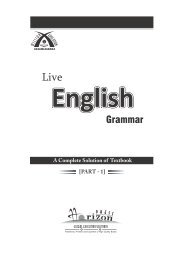
![Enjoy with Social Life-4 [74-105] - School Books Publishers India](https://img.yumpu.com/49489719/1/166x260/enjoy-with-social-life-4-74-105-school-books-publishers-india.jpg?quality=85)
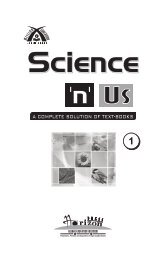
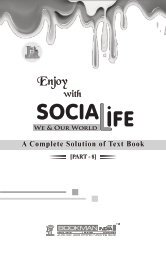

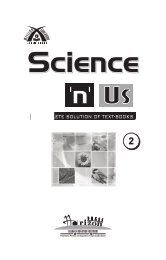
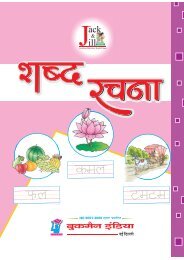


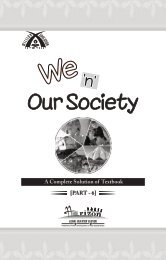
![Enjoy with Social Life-2 [26-50] - School Books Publishers India](https://img.yumpu.com/44509443/1/166x260/enjoy-with-social-life-2-26-50-school-books-publishers-india.jpg?quality=85)
